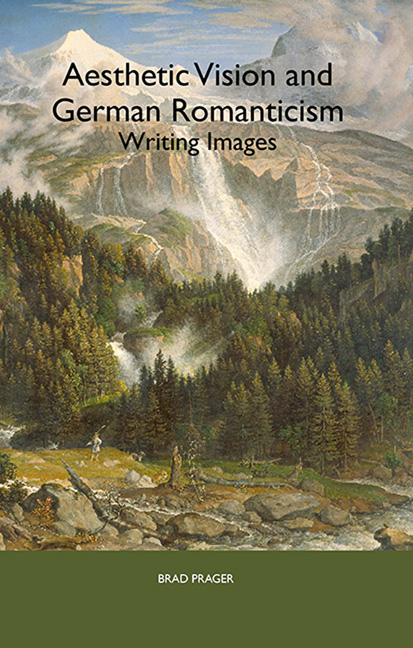Book contents
- Frontmatter
- Contents
- List of Illustrations
- Acknowledgments
- Introduction
- 1 Interior and Exterior: G. E. Lessing's Laocoon as a Prelude to Romanticism
- 2 Image and Phantasm: Wackenroder's Herzensergießungen eines kunstliebenden Klosterbruders, Tieck's Franz Sternbalds Wanderungen, and the Emergence of the Romantic Paradigm
- 3 Symbol and Allegory: Clemens Brentano's Godwi
- 4 Sublimity and Beauty: Caspar David Friedrich and Joseph Anton Koch
- 5 Light and Dark: The Paintings of Philipp Otto Runge
- 6 Absolution and Contradiction: Confrontations with Art in Heinrich von Kleist's “Die heilige Cäcilie oder Die Gewalt der Musik” and “Der Findling”
- 7 Self and Other: Joseph von Eichendorff's Das Marmorbild
- Conclusion
- Notes
- Works Cited
- Index
5 - Light and Dark: The Paintings of Philipp Otto Runge
Published online by Cambridge University Press: 13 April 2017
- Frontmatter
- Contents
- List of Illustrations
- Acknowledgments
- Introduction
- 1 Interior and Exterior: G. E. Lessing's Laocoon as a Prelude to Romanticism
- 2 Image and Phantasm: Wackenroder's Herzensergießungen eines kunstliebenden Klosterbruders, Tieck's Franz Sternbalds Wanderungen, and the Emergence of the Romantic Paradigm
- 3 Symbol and Allegory: Clemens Brentano's Godwi
- 4 Sublimity and Beauty: Caspar David Friedrich and Joseph Anton Koch
- 5 Light and Dark: The Paintings of Philipp Otto Runge
- 6 Absolution and Contradiction: Confrontations with Art in Heinrich von Kleist's “Die heilige Cäcilie oder Die Gewalt der Musik” and “Der Findling”
- 7 Self and Other: Joseph von Eichendorff's Das Marmorbild
- Conclusion
- Notes
- Works Cited
- Index
Summary
Philipp Otto Runge saw himself as the apostle of a new Romantic religion. He was undisputedly Christian, but his primary object of veneration was less the martyr's passion than the interconnectedness of man and nature. He was dissatisfied with the contemporary arts — which, in his view, demurred from presenting the unfolding of the natural world — and considered Weimar Classicism a flight into the past. He saw classicism's failure primarily in its lack of attention to color. Using Jacob Böhme's theology of light and dark as a basis, Runge developed his own approach to religious painting. For him a work had to communicate both the infinite power of divine light and man's fundamental entanglement with nature's processes. Runge's worldview, his theology, was based on the search for a transcendent standpoint from which to gain access to the true source of light, which emanated from both God and the sun. The Romantic struggle, as he saw it, was between light and darkness, a popular metaphor for depicting man's inner conflict. This particular account — this relation to the world — recalls J. G. Fichte's own system insofar as the conflict between ego and non-ego in his work was likewise staged as a struggle between darkness and light. One finds similar metaphors in F. W. J. Schelling's work, which I also discuss later in this chapter. First, however, I explore the dimensions of the conflict between light and dark in Runge's work, both in his writing and in his painting. The conflict serves as an important lens through which to understand the consequences of his thought and to come to terms with the particular way in which he depicted the inner struggle of the Romantic subject.
Born in 1777 and raised a Protestant in the town of Wolgast, on the northern Hanseatic coast of Germany, Runge and his older brother, Daniel, started work as businessmen. With the support of his father, he was eventually able to pursue painting. In 1798, at age twenty-one, he went to Copenhagen to study at the Kunstakademie, where students specialized in imitating classical style, learning to draw from antique sculptures rather than live models. After two years, however, he grew frustrated with the narrow focus of the Academy, and left Copenhagen for Dresden. There he met a number of Romantics, including Ludwig Tieck, whose Franz Sternbald had made a great impression on him.
- Type
- Chapter
- Information
- Aesthetic Vision and German RomanticismWriting Images, pp. 123 - 160Publisher: Boydell & BrewerPrint publication year: 2007



